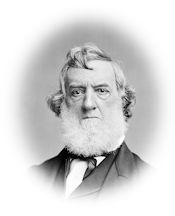March 30, Wednesday. A severe storm last night and to-day. Mrs. Welles had arranged for a party this evening. The rain ceased about sundown. The evening passed off pleasantly. A large and choice company and many celebrities.
Secretary Seward fell in with Mr. Carpenter, the artist, in the parlor. Carpenter is getting out a large painting of the President and the Cabinet at the time the Emancipation Proclamation was under consideration. The President and Cabinet have given him several sittings, and the picture is well under weigh. Mr. C. thinks this act the great feature of the Administration, as do many others likely; but Seward said it was but an incident following and wholly subordinate to other and much greater events. When C. asked what, Seward told him to go back to the firing on Sumter, or to a much more exciting one than even that, —the Sunday following the Baltimore massacre, when the Cabinet assembled or gathered in the Navy Department and, with the vast responsibility that was thrown upon them, met the emergency and its awful consequences, put in force the war power of the government, and issued papers and did acts that might have brought them all to the scaffold.
Few, comparatively, know or can appreciate the actual condition of things and state of feeling of the members of the Administration in those days. Nearly sixty years of peace had unfitted us for any war, but the most terrible of all wars, a civil one, was upon us, and it had to be met. Congress had adjourned without making any provision for the storm, though aware it was at hand and soon to burst upon the country. A new Administration, scarcely acquainted with each other, and differing essentially in the past, was compelled to act, promptly and decisively.



